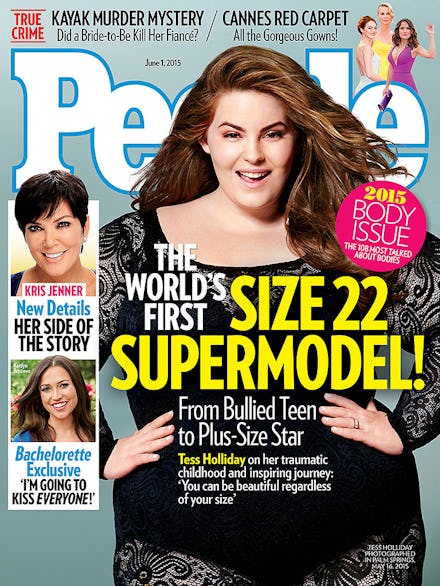Everyone's Talking About "People's" Latest Cover for a Truly Beautiful Reason

That wasn't hard, was it?
This week's issue of People is the Body Issue, and the magazine picked a rare cover star: size 22 model Tess Holliday.
The cover is just the latest achievement for the rising model, who gained national attention after signing with a major modeling agency in January, which led to more gigs and the spread of her #EffYourBeautyStandards campaign.
But a national magazine cover is a whole new level. Because despite all the lip service paid to body positivity and plus-size beauty, there are still few magazines that will put a plus-size woman on the cover — especially fashion magazines.
Magazines taking cues from fans: It's no secret that fashion and Hollywood aren't particularly receptive to diverse women's bodies. As Holliday wrote in a new blog post accompanying her People story, "After leaving school, I went to many discouraging auditions where I was told I was too short (5-foot-5) and too fat (size 22) to be a model. Thanks to the power of the Internet, I was able to create my own destiny."
That boost from the Internet, as so many models are finding, is huge because it connects them directly to fans — including women who see themselves represented by these models, whereas they almost never do in magazines and ads. Fashion cover girls still tend to skew slender (just take Vogue's recent roster with Carey Mulligan, Dakota Johnson, Karlie Kloss and Taylor Swift), with curvier women (such as Serena Williams, Melissa McCarthy and Kim Kardiashian) serving as welcome exceptions.
That's starting to change as models like Holliday earn themselves press. But the key will be for magazine publishers and ad execs to see plus-size women not for their novelty, but because their beauty and talent deserves it. Tellingly, with People, Holliday landed cover of a news magazine; she's probably a long ways away from the cover of a fashion magazine like Elle or Harper's Bazaar.
But if those magazines want to appeal to more women, they might consider putting a model like Holliday on their covers.
What women really want: It shouldn't be all too shocking that women actually enjoy seeing models who resemble them. Just last week, a Kent University study (not the first of its kind) found that women didn't respond any differently to seeing "averaged-size" models versus size zero models in ad campaigns for familiar fashion brands. Moreover, they actually responded more positively to the average models when presented with ads for new fashion brands.
Showing women with "average" bodies doesn't scare women off from buying clothing, much less magazines.
Of course, some will point out that Holliday isn't average, but rather on the other extreme end of the scale. "Concern-trolling" readers are quick to comment that models who flaunt bodies that size are "celebrating obesity" or encouraging unhealthy behavior. But showcasing a size 22 model isn't quite a public health threat, nor does it send a message that girls should go out of their way to gain weight.
Rather, showing models of all sizes is about representation. There are plenty of women whose bodies look nothing like Holliday's, just as there are women who don't possess Kate Moss' figure. The point is to see all sizes represented, so that all women can see themselves as beautiful and accepted.
As People just proved, it's not an impossible feat.